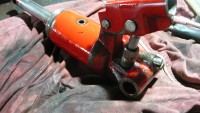Hello to all forum members. I know that the topic has already been rolled several times, I have read all the topics, but I still can't cope with my lift.
The hoist started leaking on the main cylinder. So I drained all the oil, unscrewed the `` baniaczek '', took out the actuator and changed the o-ring, because it was a bit damaged. I washed everything nicely with gasoline, flooded with hydraulic oil and the hatch! The lift is splashing with oil through the hole in the `` baniaczku '', but it has no intention of pushing the actuator.
I tried to add oil through the piston, through the actuator dropper - it did not work. After all, I did not take apart anything else, and the lift worked, only it was leaking!
I took apart the plunger, all other moving parts; there are two balls, a spring and a mushroom. I washed it, put it back together and history repeats itself ...
maybe I am making a venting error somewhere? Or maybe somewhere else on the way ....
I feel sorry to throw him away - he used it so much, and he had nothing special to say ...
I attach photos of the lift;
The hoist started leaking on the main cylinder. So I drained all the oil, unscrewed the `` baniaczek '', took out the actuator and changed the o-ring, because it was a bit damaged. I washed everything nicely with gasoline, flooded with hydraulic oil and the hatch! The lift is splashing with oil through the hole in the `` baniaczku '', but it has no intention of pushing the actuator.
I tried to add oil through the piston, through the actuator dropper - it did not work. After all, I did not take apart anything else, and the lift worked, only it was leaking!
I took apart the plunger, all other moving parts; there are two balls, a spring and a mushroom. I washed it, put it back together and history repeats itself ...
maybe I am making a venting error somewhere? Or maybe somewhere else on the way ....
I feel sorry to throw him away - he used it so much, and he had nothing special to say ...
I attach photos of the lift;





